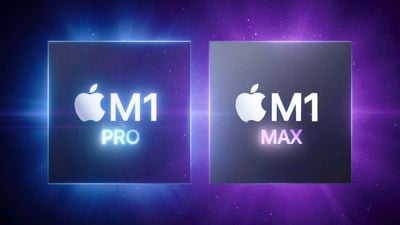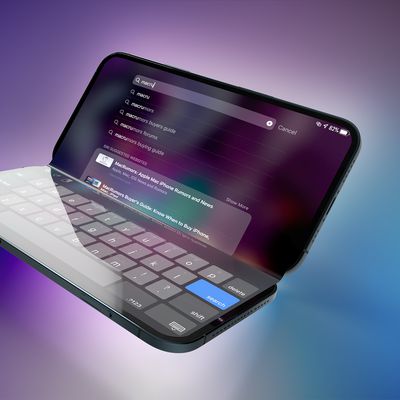AnandTech's Deep Dive Into M1 Pro and M1 Max Highlights Performance and Efficiency Improvements
We've heard Apple's overview of the the M1 Pro and M1 Max Apple silicon chips and we've seen benchmarks of the CPU and GPUs, but AnandTech has done a technical deep dive into the capabilities of the new chips that's well worth reading for those who are interested in learning more.

According to AnandTech, the M1 Pro is a new implementation of the M1 chip, but designed "from the ground up" to offer more performance. AnandTech says that this is the more interesting of the two chip designs because it offers "mostly everything that power users will deem generationally important in terms of upgrades."
The CPU cores clock up to 3228MHz peak, however vary in frequency depending on how many cores are active within a cluster, clocking down to 3132 at 2, and 3036 MHz at 3 and 4 cores active. I say "per cluster", because the 8 performance cores in the M1 Pro and M1 Max are indeed consisting of two 4-core clusters, both with their own 12MB L2 caches, and each being able to clock their CPUs independently from each other, so it's actually possible to have four active cores in one cluster at 3036MHz and one active core in the other cluster running at 3.23GHz.
The higher-end M1 Max is identical to the M1 Pro, with the exception of the GPU and the media encoders.
The GPU and memory interfaces of the chip are by far the most differentiated aspects of the chip, instead of a 16-core GPU, Apple doubles things up to a 32-core unit. On the M1 Max which we tested for today, the GPU is running at up to 1296MHz - quite fast for what we consider mobile IP, but still significantly slower than what we've seen from the conventional PC and console space where GPUs now can run up to around 2.5GHz.
AnandTech's M1 Pro and M1 Max overview goes into much more depth about the unified memory, the power behavior, and CPU and GPU performance. All in all, AnandTech says that these new chips "truly feel like SoCs that have been made with power users in mind," and performance metrics have been boosted "in all vectors."
The chips here aren't only able to outclass any competitor laptop design, but also competes against the best desktop systems out there, you'd have to bring out server-class hardware to get ahead of the M1 Max – it's just generally absurd.
The site was expecting significant boosts in performance, but "didn't expect some of the monstrous increases that the new chips are able to achieve." The chips outclass any competing laptop design, and also rival the best desktop systems available.
Popular Stories
In select U.S. states, residents can add their driver's license or state ID to the Apple Wallet app on the iPhone and Apple Watch, and then use it to display proof of identity or age at select airports and businesses, and in select apps.
The feature is currently available in 13 U.S. states and Puerto Rico, and it is expected to launch in at least seven more in the future.
To set up the...
While the iPhone 18 Pro and iPhone 18 Pro Max are not expected to launch for another nine months, there are already plenty of rumors about the devices.
Below, we have recapped 12 features rumored for the iPhone 18 Pro models.
The same overall design is expected, with 6.3-inch and 6.9-inch display sizes, and a "plateau" housing three rear cameras
Under-screen Face ID
Front camera in...
Apple hasn't updated the Apple TV 4K since 2022, and 2025 was supposed to be the year that we got a refresh. There were rumors suggesting Apple would release the new Apple TV before the end of 2025, but it looks like that's not going to happen now.
Subscribe to the MacRumors YouTube channel for more videos.
Bloomberg's Mark Gurman said several times across 2024 and 2025 that Apple would...
Earlier this month, Apple released iOS 26.2, following more than a month of beta testing. It is a big update, with many new features and changes for iPhones.
iOS 26.2 adds a Liquid Glass slider for the Lock Screen's clock, offline lyrics in Apple Music, and more. Below, we have highlighted a total of eight new features.
Liquid Glass Slider on Lock Screen
A new slider in the Lock...
The European Commission today praised the interoperability changes that Apple is introducing in iOS 26.3, once again crediting the Digital Markets Act (DMA) with bringing "new opportunities" to European users and developers.
The Digital Markets Act requires Apple to provide third-party accessories with the same capabilities and access to device features that Apple's own products get. In iOS...
2026 is almost upon us, and a new year is a good time to try out some new apps. We've rounded up 10 excellent Mac apps that are worth checking out.
Subscribe to the MacRumors YouTube channel for more videos.
Alt-Tab (Free) - Alt-Tab brings a Windows-style alt + tab thumbnail preview option to the Mac. You can see a full window preview of open apps and app windows.
One Thing (Free) -...
Apple's first foldable iPhone, rumored for release next year, may turn out to be smaller than most people imagine, if a recent report is anything to go by. According to The Information, the outer display on the book-style device will measure just 5.3 inches – that's smaller than the 5.4-inch screen on the iPhone mini, a line Apple discontinued in 2022 due to poor sales. The report has led ...
Samsung is working on a new foldable smartphone that's wider and shorter than the models that it's released before, according to Korean news site ETNews. The "Wide Fold" will compete with Apple's iPhone Fold that's set to launch in September 2026.
Samsung's existing Galaxy Z Fold7 display is 6.5 inches when closed, and 8 inches when open, with a 21:9 aspect ratio when folded and a 20:18...
Apple is working on a foldable iPhone that's set to come out in September 2026, and rumors suggest that it will have a display that's around 5.4 inches when closed and 7.6 inches when open. Exact measurements vary based on rumors, but one 3D designer has created a mockup based on what we've heard so far.
On MakerWorld, a user named Subsy has uploaded a 1:1 iPhone Fold replica (via Macworld), ...

























